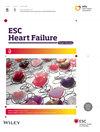Patients report increased control and decreased impact of heart failure during pulmonary pressure-guided management
Abstract
Aims
This study investigated Class III heart failure patient experience with pulmonary artery pressure (PAP) monitoring over 24 months including (1) changes in reported quality of life (QoL), (2) changes in HF illness perception and sense of control (control), (3) patient evaluation of PAP-guided therapy as a modality and (4) behavioural adherence to remote monitoring.
Methods and results
A 272 patient subgroup from the N = 1200 patient CardioMEMS™ Post-Approval Study completed 3 questionnaires including HF-related QoL, illness perception and control, and PAP therapy evaluation. Patient measurement frequency was also collected as a behavioural adherence index. Patient perception of illness was assessed via a general linear mixed model to account for all data available at all time points (n = 272). A paired analysis of patients with 24-month questionnaires (n = 135) was performed to further evaluate patients who completed follow-up. Patients reported significant improvement in overall QoL scores from baseline (44.5 ± 24.0) to 6 months (58.8 ± 25.2) which was maintained through 2 years (all P < 0.0001). Patients described their sense of control as strong (4.3 ± 0.9, 5 is strongly agree), positively evaluated PAP-guided therapy (4.1 ± 1.0, 5 is strongly agree), and 90% actively transmitted device data weekly with a significant reduction in patient perceived illness throughout 2 years of follow-up.
Conclusions
Two-year follow up of the patient experience of PAP-guided therapy indicated that patients reported increased QoL, perceptions of control, device acceptability and continued remote monitoring over the 24 month follow-up. These results suggest that knowledge of PA pressures is associated with positive patient experience and engagement in HF care.


 求助内容:
求助内容: 应助结果提醒方式:
应助结果提醒方式:


